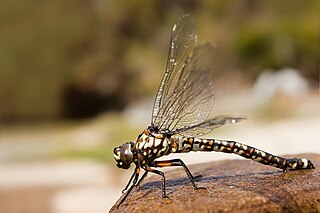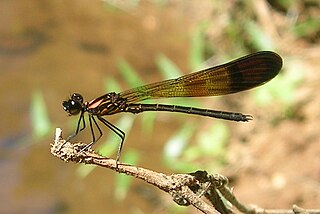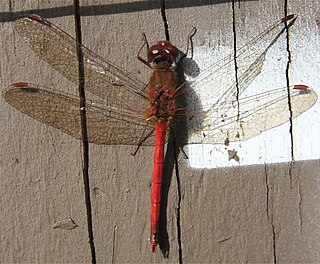
A dragonfly is a flying insect belonging to the infraorder Anisoptera below the order Odonata. About 3,000 extant species of dragonflies are known. Most are tropical, with fewer species in temperate regions. Loss of wetland habitat threatens dragonfly populations around the world. Adult dragonflies are characterised by a pair of large, multifaceted, compound eyes, two pairs of strong, transparent wings, sometimes with coloured patches, and an elongated body. Many dragonflies have brilliant iridescent or metallic colours produced by structural coloration, making them conspicuous in flight. An adult dragonfly's compound eyes have nearly 24,000 ommatidia each.

Aeshnidae, also called aeshnids, hawkers, or darners, is a family of dragonflies, found nearly worldwide, with more than 50 genera and over 450 species.

The petaltails of the family Petaluridae are among the most ancient of the extant true dragonflies, having fossil members from as early as the Jurassic, over 150 million years ago. A 2024 molecular phylogeny found that the petaltails comprise two clades, a Gondwanan clade and a Laurasian clade. Their divergence time was estimated at 160 million years ago.

The Lestidae are a rather small family of cosmopolitan, large-sized, slender damselflies, known commonly as the spreadwings or spread-winged damselflies.

The Gomphidae are a family of dragonflies commonly referred to as clubtails or club-tailed dragonflies. The family contains about 90 genera and 900 species found across North and South America, Europe, Asia, Australia, and Africa. The name refers to the club-like widening of the end of the abdomen. However, this club is usually less pronounced in females and is entirely absent in some species.
Idomacromia is a genus of dragonflies in the family Synthemistidae, which is earlier treated as a subfamily of Corduliidae. According to World Odonata List, this genera is best considered incertae sedis.

Macromidia is a genus of dragonfly in family Synthemistidae, which is earlier treated as a subfamily of Corduliidae. According to World Odonata List, this genera is best considered incertae sedis. It contains the following species:

Chlorocyphidae is a family of damselflies, commonly known as jewels. These are colorful species native to the Old World tropics, where they occur along forest streams. They are most diverse in Southeast Asia.

Sympetrum vicinum, the Yellow-Legged Meadowhawk, is one of some fifteen North American species of autumn meadowhawk, which are dragonflies in the Libellulidae family. It grows to 26–35 mm long.

Archaeophya is a small genus of dragonflies assigned to the superfamily Libelluloidea. Species of Archaeophya are large dragonflies with metallic-coloured bodies, dark with yellow spots, and clear wings. They only occur in eastern Australia.

Platystictidae is a family of damselflies, commonly known as shadowdamsels. They look very similar to the threadtail damselfly family (Protoneuridae). They can mostly be found throughout Asia, Central America, and South America.

The Synlestidae are a family of damselflies commonly known as sylphs or malachites. They occur in South Africa, Australia, and South America.

The Synthemistidae are the family of dragonflies commonly known as tigertails, or sometimes called southern emeralds. This family is part of the superfamily Libelluloidea.

Coenagrionoidea is a superfamily of closed wing damselflies of the order Odonata found worldwide.

Aeshnoidea is a superfamily of dragonflies that contains two extant families, Aeshnidae and Austropetaliidae.

Cordulegastroidea is a superfamily of dragonflies that contains three families.

Libelluloidea is a superfamily of dragonflies.
Austrocorduliidae was formerly considered a family of dragonflies occurring in South Africa and Australia. Recent taxonomic revisions have classified the species previously placed in Austrocorduliidae to now be within the superfamily Libelluloidea.
Gomphomacromiidae was formerly considered a distinct family of dragonflies occurring in Chile and Australia. Recent taxonomic revisions have classified the species previously placed in Gomphomacromiidae to now be within the superfamily Libelluloidea.

Calopterygoidea is a superfamily of damselflies in the order Odonata.

















